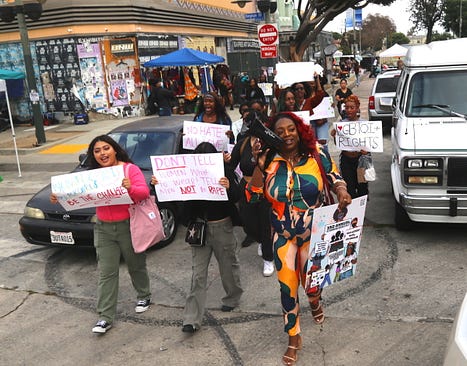
By Sikivu Hutchinson
On December 4th, twenty seven year-old Niani Finlayson, a mother of two young daughters, was shot and killed by L.A. County Sheriff’s (LASD) deputy Ty Shelton in Lancaster, California. Finlayson had called 911 after she was injured by her boyfriend during a domestic violence dispute. It is also alleged that Finlayson was trying to defend one of her daughters against abuse by this individual. The LASD claims that Finlayson was wielding a knife and threatening to stab her boyfriend when police arrived at the scene. Commenting in a multimillion dollar lawsuit filed against L.A. County, Finlayson’s lawyer stated that, she “was not threatening anyone when deputies shot her in the back from behind a glass door”. Body camera footage released this week shows that Shelton shot Finlayson only three seconds after he arrived. Finlayson’s 9 year-old witnessed her mother’s murder.
As Black women domestic and intimate partner violence survivors, we know all too well that this unspeakable tragedy could have happened to any one of us. Nationwide, Black women have disproportionately high rates of domestic violence victimization and are more likely to be killed by a partner, relative or friend than are non-Black women. In the U.S., Black women are also 2.5 times more likely to be killed by a partner, ex-partner, relative or friend than are non-Black women. In the City of Los Angeles, Black women comprise 25%-33% of all domestic and sexual violence victims, though we are only 4% of the population. These experiences make Black women and girls more vulnerable not only to assault and community violence, but also to victim-blaming, criminalization, abuse, and murder by police when they seek assistance from law enforcement. Black women are 1.4 times more likely to be killed by police than are white women. Black women domestic violence victims are more likely to be arrested when they contact law enforcement for help in a domestic violence dispute. Known as “dual arrests”, this travesty involves the concurrent arrest of the assailant and the victim in a domestic violence dispute. Racist/sexist stereotypes that criminalize Black women and girls as violent, out of control, and culpable for their own victimization, drive this disparity.

Finlayson’s senseless killing underscores why deploying violence disruptors and mental health intervention specialists who are not law enforcement is critical. In 2020, Shelton shot and killed sixty one year-old Michael Thomas in another domestic violence dispute. Shelton was not prosecuted for the killing and the officers involved in the call had not been assigned body cameras. Shelton’s continued presence on the force belies recently elected Sheriff Robert Luna’s claim that he is committed to purging “bad apples” in a department rife with killer cops and serial abusers.
In condemning this unconscionable atrocity, and expressing our condolences to Niani Finlayson’s family, we are calling on Sheriff Luna to fire Ty Shelton and deploy trained first responder violence disruptors and crisis intervention specialists during domestic violence calls, rather than armed deputies. We are also calling for the immediate prosecution of Shelton by District Attorney George Gascon.
Finlayson’s experiences, like those of other Black women domestic violence victims, also underscore the urgent need for prevention education and resources in L.A. County and city schools for all genders. Domestic and intimate partner violence prevention is only superficially discussed in middle school and high school health curricula. When domestic violence is discussed, the coverage is piecemeal and not culturally responsive to the lived experiences of Black women and girls. When the Women’s Leadership Project conducts Black feminist violence prevention education outreach in high schools, we constantly hear from Black girls who have been groomed, abused, and victimized on social media and in real time. Nationwide, Black girls across sexuality have few safe spaces to seek refuge in when they are at risk of abuse or have experienced abuse. For many Black women and women of color, early experiences with abuse are a leading predictor of later in life abuse.
L.A. County spends billions on police and prisons, yet continues to underfund restorative justice and healing justice alternatives. The County’s pledge to a “Care First” budget has yet to reap structural gains or benefits for Black L.A. youth. And the underfunding of community youth spaces only compounds the record levels of depression, suicidal ideation, and suicide that Black girls, queer and gender expansive youth are experiencing.
Niani Finlayson’s murder tragically exposes the way the intersection of police state terrorism and gaps in social welfare protections imperil Black women, Black families, and communities. Finlayson’s mom Tracie Harris stated that she was pursuing her dreams to become a nurse and create a children’s app.
You can support her family and young daughters by contributing to their GoFundMe. You can also demand the firing and prosecution of Ty Shelton by contacting Sheriff Robert Luna and District Attorney George Gascon.
The #Standing4BlackGirls coalition and Women’s Leadership Project provide mental health resources, youth leadership development, and advocacy for Black girls and BIPOC queer youth in Los Angeles.


 #Standing4BlackGirls rally in South L.A. 2022, Photo by Isaac Barrera
#Standing4BlackGirls rally in South L.A. 2022, Photo by Isaac Barrera





